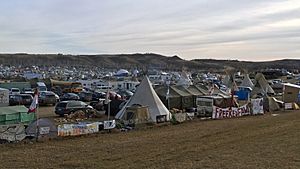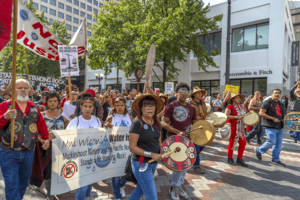Water protectors facts for kids
Water protectors are people, often Indigenous from North America, who work to defend the world's water and its natural systems. They are like land defenders, but their main focus is on water. The idea of "water protector" became well-known during the Dakota Access Pipeline protests in 2016 at the Standing Rock Indian Reservation.
These protectors see water and land as sacred, not just as resources to be used. They believe water is necessary for all life and should be treated with great respect, almost like a family member. This deep connection to water is a big part of their culture and spiritual beliefs. Historically, women have often led water protection efforts, because like water, women are seen as givers of life.

Contents
Water is life: A Sacred Connection
The phrase "Water is life" (or Mní Wichón in some Indigenous languages) is very important to water protectors. It shows the strong connection Indigenous communities have with water and all living things. "Water is life" means more than just needing clean water to drink. It also shows how water is used in special ceremonies and how important it is in their belief systems.
Many Indigenous communities see water as something that brings life to everything around it. They see water as a member of their community that needs to be protected. Because water is so highly valued, people offer gifts to it, pray to it, and sing to it. This helps them build a strong relationship with the water. Since women are seen as givers of life in Indigenous cultures, they often take on the special role of protecting the water.
What Water Protectors Do
Water protectors take action against projects that could harm water sources. This includes fighting against the building of pipelines, which carry oil and gas, and other activities like fracking, which can pollute water.
Peaceful Protests and Cultural Camps
Water protectors often use peaceful methods like blockades on their traditional lands. These blockades stop companies from starting projects that could damage the environment. They also set up resistance camps. These camps help them re-occupy and protect their traditional territories. In these camps, Indigenous people often strengthen their cultural ties. They might practice their traditional languages or ceremonies. They also perform actions rooted in ceremony, like singing songs to water, offering tobacco, and praying to the water. These actions show how important water is to their communities.
Women Leading the Way
Many water protectors are women. In many Native American and First Nations, Inuit, and Métis (FNIM) cultures, women have a special connection to water, the moon, and the tides. This is because they can become pregnant and give birth, just as water gives life. Because they give life, Indigenous women are highly respected in their communities. They are also responsible for taking care of water, believing that the water will then give life back to the environment. For example, in Anishinaabe culture, women perform ceremonies to honor water, which they believe is alive and has a spirit.
Josephine Mandamin was an Anishinaabe elder and activist. She started the Mother Earth Water Walks. She and other women walked long distances, carrying copper buckets of water, around the Great Lakes. As they walked, they sang and prayed. These walks helped strengthen the deep connections between their communities and the Great Lakes. They also raised awareness about water protection. Even after Mandamin passed away in 2019, her water walks continue to inspire many others.
Other well-known water protectors include Autumn Peltier (from the Wikwemikong First Nation), Marjorie Flowers (Inuit), LaDonna Brave Bull Allard (Dakota, Lakota), and Faith Spotted Eagle (Yankton Sioux).
Important Water Protection Efforts
Water protectors have been involved in many important movements across North America.
The Dakota Access Pipeline Protest
In 2016, Native communities protested the 1,172-mile-long Dakota Access Pipeline. They were concerned because the pipeline was planned to be built on Indigenous lands. It also threatened water sources that these communities relied on. Water protectors were at the front of this protest. They worked hard to protect the water and uphold their treaties. As experts Robin Wall Kimmerer and Kathleen Dean Moore explained, people can love land and water so much that they will live in a tent in a cold winter to protect them. This movement quickly gained media attention and became one of the biggest Native-led resistance movements in many years.
Other Pipeline and Project Protests
- Alton Gas: In May 2018, Mi'kmaq people in Nova Scotia blocked the Alton Gas company. This company wanted to take water from the Shubenacadie River for a natural gas project. The project was changing the natural balance of fresh and salt water in the river. It also threatened drinking water, fish, and other water life.
- Muskrat Falls: Water protectors have also taken action against the Muskrat Falls hydro dam project in Labrador, Canada.
- Trans Mountain Pipeline: In Burnaby Mountain, thousands of people have protested against the Trans Mountain Pipeline.
- Wetʼsuwetʼen Resistance Camps: The Wetʼsuwetʼen people have ongoing resistance camps. They are protesting the building of a Coastal GasLink pipeline in Northern British Columbia.
- Enbridge Line 3 Resistance: The Stop Line 3 protests are ongoing demonstrations in Minnesota, USA. They are against the expansion of Enbridge's Line 3 oil pipeline.
- L'eau Est La Vie Camp: Water protectors at the L'eau Est La Vie (meaning "Water is Life") camp in Louisiana resisted the Bayou Bridge Pipeline. They used direct action and legal challenges, causing delays and extra costs for the project.
Water Protectors in Books and Movies
Water protectors have been featured in many books and films, helping to share their important message.
Several children's books have been published about water protectors. The Water Walker is a picture book by Joanne Robertson. It tells the story of Josephine Mandamin and her love for nibi (water), her water walks, and why protecting water is so important. We Are Water Protectors, written by Carole Lindstrom and illustrated by Michaela Goad, won the 2021 Caldecott Medal. This story is inspired by the many Indigenous-led movements across North America. It teaches about the role of water protectors and the importance of keeping water safe.
Films and documentaries have also been made about water protectors. Awake: A Dream from Standing Rock was released in 2017. It shows the efforts of water protectors near the Standing Rock reservation to stop the Dakota Access Pipeline.
The "Water is Life" screen print, created by Anishinaabe artist and activist Isaac Murdoch, is a very famous image of water protection. Artist Christi Belcourt notes that the image of "Thunderbird woman" is a symbol of strength and resilience. Murdoch and Belcourt have made images from their Onaman Collective, including Thunderbird Woman, free to download for use at protests.
Images for kids



